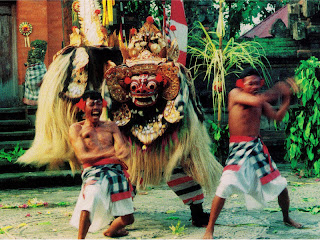Balinese Dance In the 14th century, the defeat of Bali by Majapahit led to the creation of mini-principalities and courts. As a result a blend of Javanese court and peasant culture was created in Bali. The present day accompanying narrative for dance and drama is to a large extent based on court stories from pre-Majapahit Java. The Indian epics are another favourite of the stage and the Javanese influence can be seen especially in the wayang where long quotes from the ancient Javanese Kakawin poetry are recited out. The 16th century brought Islamization to Java, resulting in much of the Javanese culture vanishing from its own land.
 |
This trend continued in the 60's and 70's with the creation of colossal sendratari ballets, representing ancient Indian and Javanese stories adapted to the needs of modern audiences Balinese dance is inseparable from religion. A small offering of food and flowers must precede even dances for tourists. Before performing, many dancers pray at their family shrines, appealing for holy "taksu" (inspiration) from the gods.
In this rural tradition, the people say that peace and harmony depend on protection by the gods and ancestors. Dance in this context may fulfil a number of specific functions:
- as a channel for visiting gods or demonic gods, the dancers acting as a sort of living repository.
These trance dances include the Sang Hyang Dedari, with little girls in trance, and the Sang Hyang Jaran, a fire dance.
- as a welcome for visiting gods, such as the pendet, rejang and sutri dances- as entertainment for visiting gods, such as the topeng and the wayang.
In some of these dances, the role of dancing is so important that it is actually the key to any meaning to be found in the ritual. In wayang performances, the puppeteer is often seen as the "priest" sanctifying the holy water. As well as their use in religious ceremonies, dance and drama also have a strong religious content. It is often said that drama is the preferred medium through which the Balinese cultural tradition is transmitted. The episodes performed are usually related to the rites taking place; during a wedding one performs a wedding story; at a death ritual there is a visit to "hell" by the heroes. Clowns (penasar) comment in Balinese, peppering their jokes with religious and moral comments on stories whose narratives use Kawi (Old-Javanese).












0 comments:
Post a Comment